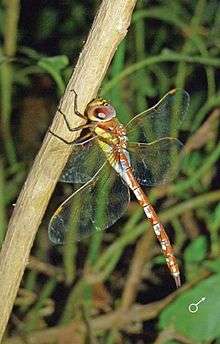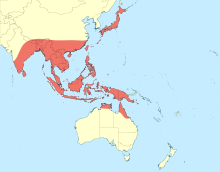Anaciaeschna jaspidea
Anaciaeschna jaspidea[3] is a species of dragonfly in the family Aeshnidae,[4] commonly known as the Australasian duskhawker[5] and Rusty darner.[6] It widely distributed from India through Australia to the Pacific.[5][7]
| Anaciaeschna jaspidea | |
|---|---|
 | |
| Male | |
| Scientific classification | |
| Kingdom: | Animalia |
| Phylum: | Arthropoda |
| Class: | Insecta |
| Order: | Odonata |
| Infraorder: | Anisoptera |
| Family: | Aeshnidae |
| Genus: | Anaciaeschna |
| Species: | A. jaspidea |
| Binomial name | |
| Anaciaeschna jaspidea (Burmeister, 1839)[2] | |
 | |
Description and habitat
It is a large brown dragonfly with blue eyes. Its thorax is reddish-brown, with two broad greenish-yellow stripes on each side. Wings are transparent with pterostigma, reddish-brown. Abdomen is reddish-brown, marked with azure-blue, white, and yellow. Segment 1 has a large pale yellow spot on each side. Segment 2 has white marks on the sides and azure-blue on the dorsum with a broad spot of reddish-brown on mid-dorsum. Segment 3 to 7 are brown on dorsum with black apical annules. Segments 8 to 10 are darker on dorsum with a pair of dorsal apical spots. Anal appendages are dark reddish-brown. Female is similar to the male.[8][9]
.jpg) Female wings
Female wings.jpg) Male wings
Male wings
It is a crepuscular species, flies during dawn and dusk. It is common in marshes surrounded by woods where it breeds.[9][10]
Note
The Australasian duskhawker, Anaciaeschna jaspidea, should not be confused with almost-similarly named Australian duskhawker, Austrogynacantha heterogena, a different species of Aeshnid dragonfly.
See also
- List of Odonata species of Australia
- List of odonata species of India
- List of odonata of Kerala
References
| Wikimedia Commons has media related to Anaciaeschna jaspidea. |
| Wikispecies has information related to Anaciaeschna jaspidea |
- Dow, R.A. (2010). "Anaciaeschna jaspidea". IUCN Red List of Threatened Species. 2010: e.T167168A6311033. doi:10.2305/IUCN.UK.2010-4.RLTS.T167168A6311033.en.
- Burmeister, Hermann (1839). Handbuch der Entomologie (in Latin and German). 2. Berlin: T.C.F. Enslin. pp. 805–862 [840] – via Biodiversity Heritage Library.
- Martin Schorr; Dennis Paulson. "World Odonata List". University of Puget Sound. Retrieved 12 Oct 2018.
- "Species Anaciaeschna jaspidea (Burmeister, 1839)". Australian Faunal Directory. Australian Biological Resources Study. 2012. Retrieved 8 February 2017.
- Theischinger, Günther; Hawking, John (2006). The Complete Field Guide to Dragonflies of Australia. Collingwood, Victoria, Australia: CSIRO Publishing. p. 148. ISBN 978 0 64309 073 6.
- "Anaciaeschna jaspidea Burmeister, 1839". indiabiodiversity.org. India Biodiversity Portal. Retrieved 2017-02-10.
- K.A., Subramanian; K.G., Emiliyamma; R., Babu; C., Radhakrishnan; S.S., Talmale (2018). Atlas of Odonata (Insecta) of the Western Ghats, India. Zoological Survey of India. pp. 183–184. ISBN 9788181714954.
- Watson, J.A.L.; Theischinger, G.; Abbey, H.M. (1991). The Australian Dragonflies: A Guide to the Identification, Distributions and Habitats of Australian Odonata. Melbourne: CSIRO. ISBN 0643051368.
- C FC Lt. Fraser (1936). The Fauna of British India, including Ceylon and Burma, Odonata Vol. III. Red Lion Court, Fleet Street, London: Taylor and Francis. pp. 152–154.
- Theischinger, Gunther; Endersby, Ian (2009). Identification Guide to the Australian Odonata. Department of Environment, Climate Change and Water NSW. p. 190. ISBN 978 1 74232 475 3.
